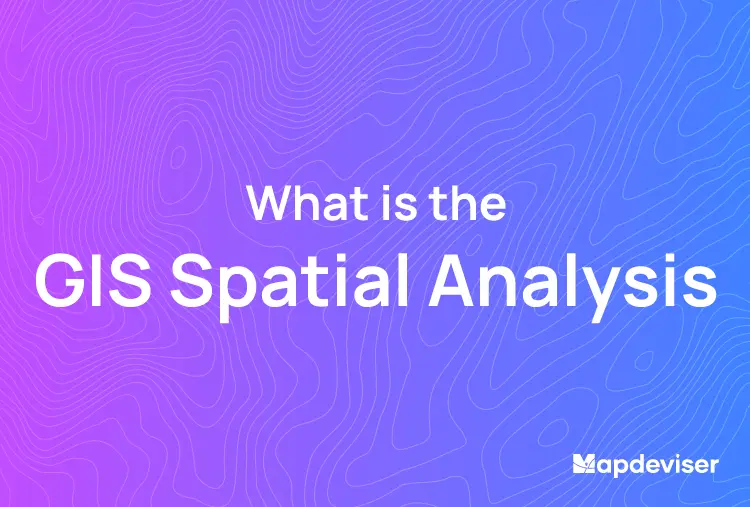
Introduction to Geographic Information Systems (GIS)
Geographic Information Systems (GIS) are excellent aids in grasping and controlling our geographic surroundings. They let us gather, keep, examine, and demonstrate geographic data. We get knowledge about the spread, models, and connections of aspects of various landscapes. It’s fascinating how GIS tech is now everywhere. You can see it in city planning and environmental care, even in public health and business analytics.
Spatial analysis is key in GIS. It lets us dig into the space features of data. Lots of methods can help us pull useful info from the geography data. We use tools for spatial analysis to spot patterns and trends, measure space relations, weigh risks, and make smart choices with a full view of space settings.
This blog post explores the fascinating world of GIS spatial analysis. We will uncover the core concepts that form the basis of this field and unravel the complexities of spatial data and the techniques used to gain valuable insights. Throughout our journey, we will discover how spatial analysis is applied in different disciplines and how it transforms decision-making.
“Mapdeviser” who is an Expert in designing Custom Maps that bring your concepts into reality with precision and artistry, we are there for you to help in GIS Data visualization, Custom Map Designs, Map Illustrations, and Geospatial Solutions. This article provides you the Insights on GIS Spatial Analysis.
Unveiling the Fundamental Concepts of Spatial Analysis
Understanding Spatial Data
Spatial data forms the cornerstone of GIS spatial analysis, representing the real-world features and phenomena we seek to understand. It encompasses a diverse range of data types, including vector data, raster data, and attribute data.
Vector data represents geographic features as discrete points, lines, and polygons, capturing their precise locations and shapes. Raster data, on the other hand, portrays the world as a grid of cells, each containing a value representing the characteristics of that location. Attribute data provides additional information about geographic features, such as their names, descriptions, and associated properties.
Exploring Spatial Relationships
Spatial relationships are the fundamental building blocks of spatial analysis, defining the connections and interactions between geographic entities. They encompass a range of concepts, including proximity, adjacency, containment, and direction. Understanding these relationships is crucial for identifying patterns, trends, and associations within spatial data.
Delving into Spatial Analysis Techniques
A diverse array of spatial analysis techniques empowers us to extract meaningful insights from geographic data. These techniques can be broadly categorized into three main groups:
- Measurement and description: This group of techniques involves quantifying spatial relationships, such as distance, area, and density.
- Pattern analysis: This group focuses on identifying patterns and trends within spatial data, such as clustering, dispersion, and association.
- Modelling and prediction: This group utilizes spatial analysis techniques to develop models that can predict spatial patterns or relationships.
Uncovering the Practical Applications of GIS Spatial Analysis
GIS spatial analysis is a powerful tool used in various fields, going beyond academia. Let’s explore some practical applications.
- Urban planning: Spatial analysis tools are employed to assess land suitability, optimize infrastructure placement, and analyze demographic trends for informed urban planning decisions.
- Environmental management: Spatial analysis plays a crucial role in assessing environmental risks, monitoring natural resources, and developing conservation strategies.
- Public health: Spatial analysis techniques are used to identify disease hotspots, track the spread of infectious diseases, and plan healthcare interventions.
- Business intelligence: Spatial analysis empowers businesses to analyze customer demographics, optimize marketing strategies, and identify potential market opportunities.
Understanding GIS:
Definition of GIS
Geographic Information Systems (GIS) are potent tools. They help us grab, keep, study, and depict geographic information. GIS give a detailed layout for grasping and dealing with space-related info. They cover a generous mix of data kinds like maps, satellite pictures, and numbers data.
Key Components of GIS:
- Hardware: The physical components of a GIS system, including computers, servers, and specialized input devices like digitizers and GPS receivers.
- Software: The suite of software applications that enable users to create, manage, and analyze geographic data. GIS software typically includes tools for data input, editing, visualization, and analysis.
- Data: The foundation of any GIS system, consists of geographic information stored in various formats, such as vector data, raster data, and attribute data.
- People: The individuals who use and manage GIS systems, including data collectors, analysts, and decision-makers.
The Role of GIS Spatial Data
GIS relies heavily on spatial data – it’s the main ingredient for study and illustration. This data comes in many forms, each one showing a unique part of the spatial environment.
Types of GIS Spatial Data:
Vector data: Represents geographic features as discrete points, lines, and polygons, capturing their precise locations and shapes.
Raster data: Portrays the world as a grid of cells, each containing a value representing the characteristic of that location.
Attribute data: Provides additional information about geographic features, such as their names, descriptions, and associated properties.
Spatial data plays a crucial role in GIS by enabling us to:
- Visualize spatial patterns and relationships: GIS software allows us to create maps and visualizations that effectively convey the distribution and connections between geographic features.
- Study space info: GIS gives us tools to explore space data. This helps us count distances, size up areas, spot trends, and evaluate ties.
- Choose smartly: By grasping space trends and ties, we make smart choices about how to use land, how to manage resources, and other space-linked topics.
The Essence of GIS Spatial Analysis:
Definition of Spatial analysis is a crucial part of Geographic Information Systems (GIS). It involves various techniques that help us uncover valuable insights from geographic data. It’s not just about mapping features; it explores the spatial aspects of data, allowing us to uncover hidden patterns, trends, and relationships. Through spatial analysis, we gain a deeper understanding of our surroundings and how different elements interact in space.
Significance of GIS Spatial Analysis:
Spatial patterns can be revealed through spatial analysis techniques. These techniques help us identify and understand how geographic features are distributed and related to each other. By analyzing spatial data, we gain insights into patterns and trends that exist in our environment.
GIS Spatial analysis allows us to measure and comprehend the relationships between different geographic features. It helps us understand aspects like proximity, adjacency, and containment.
GIS Spatial analysis techniques are used to create models that can predict spatial patterns or relationships. These models give important experiences to informed direction.
Improving Decision-Making Efficiency
GIS Spatial analysis empowers decision-makers by providing a comprehensive understanding of spatial contexts. By analyzing GIS spatial data, decision-makers can:
Identify optimal locations: Spatial analysis tools can be used to identify the most suitable locations for various purposes, such as siting facilities, planning infrastructure, and selecting conservation areas.
Assess spatial impacts: Spatial analysis enables us to evaluate the potential impacts of proposed projects or interventions on the surrounding environment and communities.
Optimize resource allocation: Spatial analysis techniques can be employed to optimize resource allocation, ensuring that resources are directed to the areas where they are most needed.
Enhancing Decision-Making Effectiveness
Spatial analysis has a dual advantage. It not only makes decision-making more efficient but also amplifies its effectiveness.
Spatial analysis is a method of making decisions based on data. It helps ensure that decisions are guided by objective evidence instead of personal assumptions.
Spatial analysis is a useful tool for gaining a complete understanding of spatial contexts. By examining the connections between geographic features and their surrounding environments, we can develop a holistic perspective.
Risk assessment and mitigation: Spatial analysis tools can be used to identify and assess potential risks associated with various scenarios, enabling proactive mitigation strategies.
Conclusion
GIS spatial analysis is an essential tool for understanding and managing our spatial world. It helps us extract valuable insights from geographic data, revealing hidden patterns, trends, and relationships. By exploring the spatial dimensions of data, GIS spatial analysis enables informed decision-making, problem-solving, and a deeper understanding of the intricate patterns that shape our surroundings.
GIS spatial analysis holds great importance in shaping our future as technology advances and spatial data grows. Its applications span various fields, including urban planning, environmental management, public health, and business intelligence. By utilizing GIS spatial analysis, we are empowered to tackle pressing challenges, optimize resource allocation, and make informed decisions that contribute to a sustainable and equitable future for our planet.
We think that this is the thing you’re attempting to find and Trust to join with us for your requirements in GIS Spatial Analysis. We “Mapdeviser”, are dedicated to delivering high-quality, accurate and aesthetically pleasing maps, combined with our proficiency in using the latest mapping tools and technologies.
FAQs
What are the key benefits of using GIS spatial analysis?
GIS spatial analysis provides numerous benefits, including:
- Uncovering hidden patterns and relationships: Spatial analysis techniques allow us to identify patterns and trends within spatial data that would otherwise be difficult to perceive, providing insights into the distribution and connections between geographic features.
- Enhancing decision-making: By understanding spatial patterns and relationships, we can make informed decisions about land use, resource management, and other spatially related issues.
- Improving efficiency and effectiveness: GIS spatial analysis can optimize resource allocation, reduce costs, and streamline processes, leading to greater efficiency and effectiveness in various fields.
- Enabling data-driven problem-solving: GIS spatial analysis provides a data-driven approach to problem-solving, ensuring that decisions are based on objective evidence rather than subjective assumptions.
What are some of the common challenges faced in GIS spatial analysis?
GIS spatial analysis faces several challenges, including:
- Challenges with quality and uniformity of Data: Ensuring top-notch and uniform data plays a vital role in precise spatial analysis. However, geographic data often faces issues with inconsistencies, errors, and lack of complete data, leading to undependable outcomes.
- Difficulties in merging and handling data: Merging and handling different spatial datasets from varied sources can be a demanding task. It requires proficiency in data standardization, harmonization, and storage.
- Computational demands and processing limitations: Spatial analysis often involves processing large volumes of complex geographic data, demanding significant computational resources and efficient algorithms to handle the processing demands.
- Skillset requirements and expertise gap: Conducting effective spatial analysis requires a combination of technical skills, domain knowledge, and analytical expertise. Finding individuals with the necessary skills can be challenging, particularly in specialized fields.
How can we overcome these challenges and enhance GIS spatial analysis capabilities?
Several strategies can be employed to address the challenges faced in GIS spatial analysis:
- Implement rigorous data collection and validation procedures.
- Standardize and harmonize data formats, projections, and coordinate systems.
- Utilize data preprocessing techniques to improve data quality and address inconsistencies.
- Leverage high-performance computing resources and parallel processing techniques.
- Foster interdisciplinary collaboration between GIS specialists, domain experts, and data scientists.
- Promote knowledge sharing through open data initiatives and open-source software development.
- Invest in capacity-building and training programs to enhance the skillsets of GIS professionals.
- Engage with the GIS community through workshops, conferences, and online forums.
- Embrace emerging technologies, such as artificial intelligence, machine learning, and big data analytics, to develop new tools and approaches for spatial analysis.





